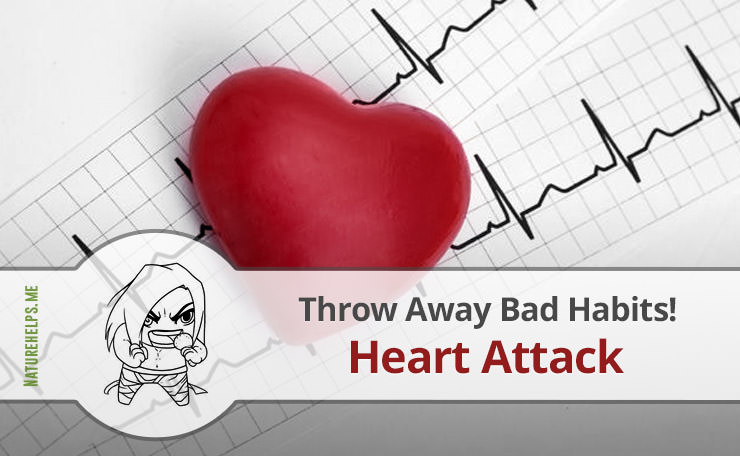About 80% of heart attacks can be prevented. According to World Health Organization people can protect themselves with rather simple steps and actions, but these actions should be taken as soon as possible. Take a minute and think about which ways you can chose: do something now and be healthy whole time, or don’t concern such miserable thing and wait for heart attacks in future.
Prerequisites for coronary thrombosis appear long before actual heart attack. With time cholesterol plaques are growing inside arteries (main lines of blood flow) and they narrow the lumen of blood vessels, obstructing blood flow. And then at some point this little “pass” completely blocked by thrombus – a blood clot. Oxygen and nutrients are no longer delivered to the heart and as the result tissues die. This is a heart attack, requiring emergency medical care.
Blocked arteries caused by plaque buildup and blood clots are the leading cause of death in the U.S. and in some others developed countries. Reducing cholesterol and other risk factors can help prevent cholesterol plaques from forming. Occasionally, it can even reverse some plaque buildup.
It’s time to start working at self-improving until the emergency situations reached. Atherosclerosis and pathological thrombosis, heart attack – all disease can be beaten by simple yet effective actions…
Throw out cigarette, stop smoking and say welcome to diets
Hackneyed phrase – healthy lifestyle plays important role in the prevention of heart attack. You can’t say anything else, just repeat it by yourself: “healthy lifestyle”, and again “healthy lifestyle”
Quit smoking. Tobacco smoke inhalation leads to blood vessels spasm, their walls become more vulnerable to deposition of cholesterol, increasing blood clotting and raising the risk of thrombosis. It is not surprising that those who smoke is subjected to heart attacks, and the heart problems usually starts long before old age. At the same time just a year after smoke quitting the risk of heart attack can be reduced by 50%.
Obesity and heart problems
Watch out for what you eat. Obesity is an increasingly prevalent metabolic disorder affecting not only the US population but also that of the developing world. It is estimated from the third National Health and Nutrition Examination Survey (NHANES III) (1988-1991) that 33% of the US population is obese, compared with 25% in NHANES II (1976-1980). And such statistic has a good correlation with observational data about people who suffer heart attack.
An extra-large body needs an extra-large amount of blood. When you put on weight, your heart needs to pump more blood to additional tissues than it did before. Rather than beating more frequently, the heart becomes somewhat bigger so it can move more blood with every beat (remember, heart is just muscle tissue and increased load leads to increasing muscles). It’s similar to a spigot that has been opened up a notch. The increased flow often leads to high blood pressure, which is a major cause of heart disease.
Regardless of the possibility that your blood pressure doesn’t climb, your heart can experience bad effects of the additional workload. When the chambers of the heart grow larger, they slowly lose some of their squeezing power. Eventually, they may not be able to completely empty themselves with each beat. As blood starts pooling in your heart, you can develop congestive heart failure.
Large amounts of belly fat can blunt the effects of insulin, making you vulnerable to type 2 diabetes, a condition that seriously threatens the heart. Extra fat in the body can also lead to extra fat in the blood. Overweight people often have high levels of artery-clogging LDL cholesterol. If too much cholesterol sticks to your arteries, a condition called atherosclerosis, you can suffer a heart attack or a stroke.
However, atherosclerotic plaques often can be found in lean people, if they abuse the animal food: fatty meats, cheeses, fatty dairy products. Revise your daily menu and introduce a lot of vegetables, fruits and cereals which are rich in soluble fiber. Start eating 2-3 times a week fatty fish, saturated with polyunsaturated fatty acids (omega-3). This ensured that the blood vessels walls become more elastic and less permeable to cholesterol. And of course, you need to watch weight and keep it within the normal range.
Regular physical activity trains the heart and improves the blood vessels condition; also burning excessive calories regulates weight gain. By combining regular workouts with a low-calorie diet, you can reduce your weight by 10 percent in about six months. At a minimum, the American Heart Association and the Centers for Disease Control and Prevention (CDC) recommend 150 minutes of moderate exercise, or 60 to 75 minutes of vigorous exercise, each week. On at least two of those days, the CDC recommends muscle strengthening workouts that exercise all the major muscle groups. You should also aim to burn 500 to 1,000 calories more than you eat each day.
Watch over your health
To prevent any diseases and actual heart attack it is necessary to constantly control body condition.
Regular blood-pressure checks. If your blood pressure is ‘normal’ and you have no other risk factors for cardiovascular disease, and no personal or family history of high blood pressure, you should still have a check every two years and during routine visits to your doctor.
If your blood pressure is ‘high–normal’ (or higher), or if you have other risk factors for cardiovascular disease, a personal or family history of high blood pressure, stroke or heart attack, it is best to have it checked more frequently. It is best to purchase a home blood pressure device and use it one o two times per week.
Watch for blood glucose levels. If you have diabetes, you are at least twice as likely as someone who does not have diabetes to have heart disease or a stroke. People with diabetes also tend to develop heart disease or have strokes at an earlier age than other people. If you are middle-aged and have type 2 diabetes, some studies suggest that your chance of having a heart attack is as high as someone without diabetes who has already had one heart attack. Women who have not gone through menopause usually have less risk of heart disease than men of the same age. But women of all ages with diabetes have an increased risk of heart disease because diabetes cancels out the protective effects of being a woman in her child-bearing years.
People with diabetes who have already had one heart attack run an even greater risk of having a second one. In addition, heart attacks in people with diabetes are more serious and more likely to result in death. High blood glucose levels over time can lead to increased deposits of fatty materials on the insides of the blood vessel walls. Check the “sugar” at least once a year.
Monitor cholesterol (lipids) in the blood. This indicator allows us to estimate the risk of developing atherosclerosis or a illness stage. Today such tests can be performed at home. Approved by the FDA in 1993, home cholesterol tests generally measure the total fat levels in your blood. A few years ago, some manufacturers also started producing home cholesterol tests that measure high-density lipoprotein (HDL), the “good” cholesterol that protects your heart; low-density lipoprotein (LDL), the “bad” cholesterol which contributes to plaque buildup in the arteries; and triglycerides.
To use the cholesterol tests, you prick your finger with a small lancet, put a drop of blood on a piece of paper with chemicals on it, and wait for the results (usually within 10 minutes or so). In some tests, you can tell your results by the color of the paper. In others, your result appears on a small screen – often within one minute.
The results of home cholesterol tests are about 95% accurate – very close to the accuracy of a doctor’s (or laboratory’s) test. This test is desirable to carry out once a year.
If you are at heart attack risk group
Tips for following a healthy lifestyle are relevant to everyone. But certain traits, conditions, or habits may raise your risk for coronary heart disease. These conditions are known as risk factors. Risk factors also increase the chance that existing heart problems will worsen.
- you have diabetes mellitus;
- you expressed overweight or obese;
- some of your blood relatives had a heart attack at a young age;
- you have hypertension;
- you have high cholesterol;
- you have identified coronary heart disease, or already had a stroke or heart attack.
Having just one risk factor doubles your risk for heart attack. Having two risk factors increases your risks fourfold. Having three or more risk factors increases noticeably the probability of heart diseases development.
Medicine that can helps to prevent heart attack
Proven medicine for most of the heart problems is well known acetylsalicylic acid (Aspirin). Taking aspirin helps prevent blood clots from forming in your arteries, and may help lower your risk of a stroke or heart attack.
Aspirin helps get more blood flowing to your legs. It can treat a heart attack and prevent blood clots when you have an abnormal heartbeat. You probably will take aspirin after you have treatment for clogged arteries.
- For people who are having a heart attack. You can take aspirin to help you during a heart attack. It slows blood clotting, so a blood clot that is causing the heart attack stays smaller.
- For people who have had a heart attack, Aspirin can help prevent a second heart attack.
- For people who have never had a heart attack. Aspirin may reduce your chance of having a heart attack or a stroke even if you have certain risk factors at once.
Anyways, just find some time, revise your agenda and take a walk on fresh air. Good physical activity combined with healthy food will be a better healer.

